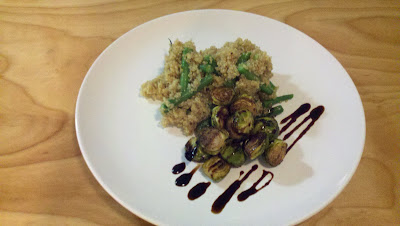Citrus Shrimp with Coconut Brown Rice and Glazed Carrots
Serves 4
February Recipe of the Month...Simple, Healthy and Delicious,
thanks Chef Jon, can't wait to try this one!
Ingredients:
1 lb - shrimp, deveined
1 lb - shrimp, deveined
1
lb - carrots, peeled
1 Tbsp - Pastamore Citrus Balsamic Vinegar
1 Tbsp - vegetable oil
1.5 cups - short grain brown rice
3 cups - water
4 fl oz - lite coconut milk
1 - shallot, minced
1 Tbsp - Pastamore Meyer Lemon Oil
1 Tbsp - flour
2 cups - water, cold
1 - lime
1 - lemon
1 - orange
To taste - salt and black pepper
1 Tbsp - Pastamore Citrus Balsamic Vinegar
1 Tbsp - vegetable oil
1.5 cups - short grain brown rice
3 cups - water
4 fl oz - lite coconut milk
1 - shallot, minced
1 Tbsp - Pastamore Meyer Lemon Oil
1 Tbsp - flour
2 cups - water, cold
1 - lime
1 - lemon
1 - orange
To taste - salt and black pepper
Directions:
1. Combine short grain brown rice and 3 cups of water in a pot. Place on the stove over high heat and bring to a boil. Reduce to a simmer and cover. Cook time will take approximately 50 minutes.
2. After the rice has been cooking for 10 minutes, preheat oven to 400°F. Place the Pastamore Citrus Balsamic Vinegar into a large mixing bowl. Slowly drizzle the vegetable oil into the bowl using a whisk to incorporate the oil (making a dressing). Chop the peeled carrots into 1/2"-3/4" long pieces. Add the carrots to the Pastamore Citrus Balsamic and vegetable oil mixture. Season with salt and pepper, and mix well. Place onto a greased baking sheet, and place into the oven. Cook time will take approximately 20-30 minutes.
3. Zest the lemon, lime, and orange. Place the zest in a small mixing bowl. Next, juice the lemon, lime, and orange into the same bowl as the zest.
4. Place a large saucepan on the stove over medium heat. When the pan is hot, add the Pastamore Meyer Lemon Oil. When the oil is hot, add the minced shallot. Sweat the shallot until it is translucent (if the shallot is becoming brown reduce the heat). Add the flour to the pan and mix together using a whisk. Next, add the zest and juice from the lemon, lime, and orange. Whisk again to mix well. Next, add 1 cup of water. Bring to a simmer. After simmering, add more water if needed to create a thinner consistency. Season with salt and pepper to taste.
5. When the carrots are finished cooking, remove them from the oven. When the rice is done, remove the pot from the heat and add the lite coconut milk and season with salt and black pepper. Mix well. Add the shrimp to the simmering sauce. Turn the shrimp over once during the cooking process. Cook time for the shrimp should only be a few minutes (firm to the touch, but be careful to not overcook because they will become stringy.
6. Plate the coconut rice and carrots. Next, plate the shrimp on top of the rice, and spoon the citrus sauce over the shrimp.








